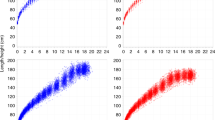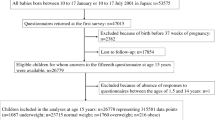Abstract
AMONG the well-known anthropometric formulæ due to Prof. Dreyer of Oxford (see Lancet, August 9, 1919, and NATURE, August 26, 1920), there is one connecting weight, W, with stem-length, or height of trunk alone,, namely, W = 0.3800·319. This gives a ratio of the type Wn/ = K, and is of special interest because, when dealing with averages of large numbers, it seems to show surprisingly little variation with age during the important adolescent period of life. To test it I used data relating to Manchester Grammar School boys, for which I am indebted to Dr. Mumford, Medical Officer of the School. The school measurements of height and weight have been taken on a uniform basis for about forty years; measurements of stem-length were taken in addition in 1921 and 1923. If the stem-length is replaced by the full height (H), and if 0·319 (n) is replaced by the approximate value " in Dreyer's formula, I find that the ratio is even less variable. Table 1 shows the values of W"/H, calculated from the mean values of W and H, for groups of boys varying in age from 9 to 19 years at three different periods of time. In the same table are shown, for comparison, calculations of the same ratio for Schuster's observations of undergraduates, and of W0·319/ for the Grammar School boys in 1921, 1923. Measurements were expressed in C.G.S. units, but significant figures only are printed.
This is a preview of subscription content, access via your institution
Access options
Subscribe to this journal
Receive 51 print issues and online access
$199.00 per year
only $3.90 per issue
Buy this article
- Purchase on Springer Link
- Instant access to full article PDF
Prices may be subject to local taxes which are calculated during checkout
Similar content being viewed by others
Change history
01 April 1926
NATURE of April 10, p. 516, end of penultimate paragraph in Col. 1; for “standard deviation, 74·7 “read” standard deviation, 7·47.”
Author information
Authors and Affiliations
Rights and permissions
About this article
Cite this article
JONES, D. The Relation of Weight to Height during Adolescence. Nature 117, 515–516 (1926). https://doi.org/10.1038/117515b0
Issue Date:
DOI: https://doi.org/10.1038/117515b0
Comments
By submitting a comment you agree to abide by our Terms and Community Guidelines. If you find something abusive or that does not comply with our terms or guidelines please flag it as inappropriate.



